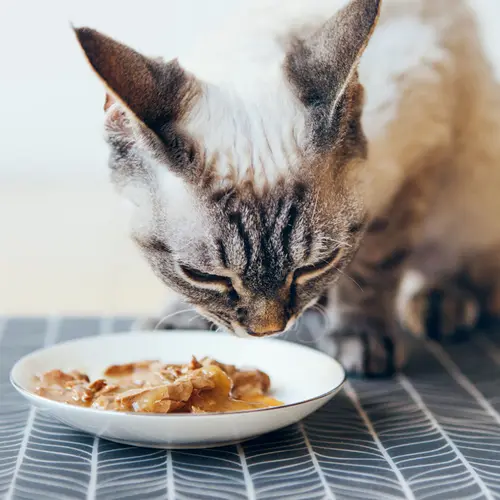The feline parvovirus, more commonly known as Panleukopenia or Feline Distemper, is a virus that causes diarrhea, vomiting, and fever. It can cause severe disease, especially in kittens, and is often fatal. This disease is also known as feline panleukopenia, feline infectious enteritis (FIE), and feline distemper.
The specific virus that infects dogs does not infect cats, so cats can't get feline parvo from dogs. But dogs do get infected by a similar virus called the canine parvovirus-2 (CPV-2). The original CPV-2 can't infect cats, but newer variants (CPV-2a, CPV-2b, and CPV-2c) can infect your cat.
What Is Parvo in Cats?
Parvo is a term used for the disease caused by the feline parvovirus. The illness is most common and severe in kittens. At birth, most kittens have antibodies from their mother. These antibodies protect them for the first few weeks. By the age of 4 to 12 weeks, this protection wanes, and the kittens become vulnerable to the virus.
Feline parvo is most common in cats 3 to 5 months old. The feline parvovirus is widespread in the environment, and almost all cats are exposed to it. Apart from young kittens, sick cats and unvaccinated cats are most likely to get this disease.
Cats can get infected during pregnancy and give birth to brain-damaged kittens. These kittens have difficulty walking and feeding.
The feline parvovirus attacks the cells in your cat's intestines, which causes diarrhea, vomiting, and difficulty eating and drinking. It also attacks the bone marrow, causing shortages of red blood cells, white blood cells, and platelets.
How Do Cats Get Parvo?
This virus is passed in poop, urine, and nasal secretions by cats who have the disease. The virus can contaminate cages, bedding, dishes, and the hands and clothes of handlers. Fleas from other infected cats can also infect your cat. The virus can survive in the environment for months, so your cat can get this disease without any contact with a diseased cat.
Cat-to-cat passage of the feline parvovirus also happens. This is more likely in multicat households, animal shelters, pet shops, and other places where several cats live together.
What Are the Symptoms of Parvo in Cats?
The feline parvovirus does not always cause symptoms. Some cats have the infection and no visible disease. The usual symptoms of cats sick with the parvovirus are:
- Lethargy and depression
- Frothing at the mouth or vomiting
- Watery discharge from the nose
- Fever in the early stages, followed by a low body temperature
- Diarrhea, which may be watery or bloody
- Decreased appetite
The disease can progress in severity and lead to death. Sometimes, a cat may have no symptoms but die suddenly.
Cats usually only pass the parvovirus in their stools or body fluids like urine or even nasal secretions for two days or so after they are infected. But some cats go on excreting this virus through stools for up to six weeks while appearing to be healthy. These carrier cats can infect the environment and other cats living with them.
In the early stage of the disease, your sick cat may sit for a long time in front of their food or water bowl, unable to consume much.
A fever may happen during this early stage and rise to a high level. In advanced disease, your cat's body temperature may fall to lower-than-normal levels. This can be a sign of impending death.
How Is Cat Parvovirus Diagnosed?
Feline parvovirus disease can be difficult to diagnose, as its symptoms vary from mild disease to severe, fatal illness. The illness caused by this virus is also similar to that of a salmonella or campylobacter infection, a feline immunodeficiency virus (FIV) infection, a feline leukemia virus (FeLV) infection, and pancreatitis.
Along with the symptoms, a history of exposure and a lack of vaccination make this disease likely. Your veterinarian may order stool and blood tests to diagnose this disease. The laboratory may identify the virus in your cat's stools. The blood test would show a reduced number of all cell types (pancytopenia), a characteristic of feline parvovirus disease.
What Is the Treatment for Cat Parvovirus?
There are no medicines that can kill this virus. Good supportive care with intravenous fluids, nutrients, and antibiotics to prevent secondary bacterial infection may help your cat survive. Kittens have high mortality rates. Older cats have a better chance of surviving.
How Do You Prevent Cat Parvovirus?
The most effective way of protecting your cat is by vaccination. Your veterinarian will usually advise you to start vaccination at the age of 8 or 9 weeks. Two or three doses, three to four weeks apart, are recommended. The last of these should not be before the age of 16 weeks. A follow-up dose at 26 to 52 weeks is now recommended.
Adult cats can also get the feline parvovirus. You must remember to give the booster doses of the vaccine regularly. Both live and killed vaccines are available and are very effective.
If one of your cats has a feline parvovirus infection, they must be isolated from other cats. Their litter box must be cleaned and disinfected regularly. The feline parvovirus can survive in the environment for many months, so you must disinfect your entire home to keep your other pets safe. If your other cats are not vaccinated, they are at a high risk.

